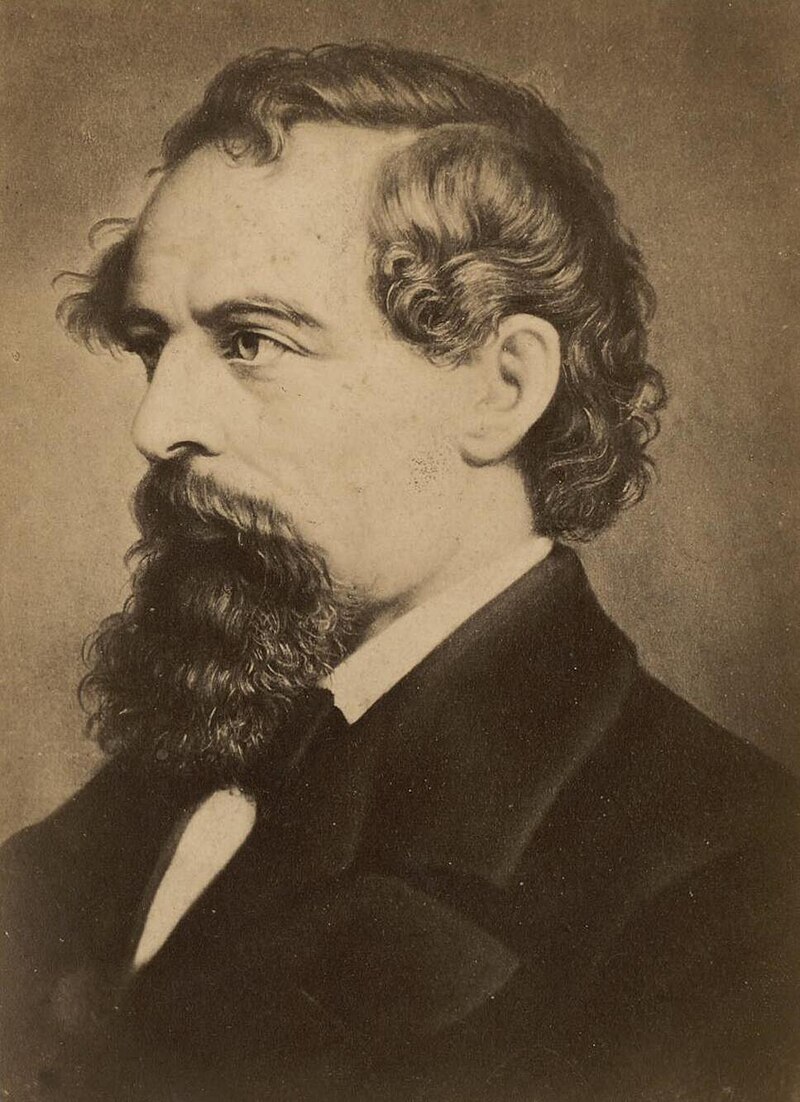
| Version | Summary | Created by | Modification | Content Size | Created at | Operation |
|---|---|---|---|---|---|---|
| 1 | Encyclopedia Editorial Office | -- | 822 | 2025-06-09 05:49:53 |
Video Upload Options
Charles John Huffam Dickens (7 February 1812–9 June 1870) was a preeminent novelist and social critic of Victorian England. His masterful portrayal of social injustice, inventive characterizations, and pioneering use of serialized narrative radically transformed English literature.
I. Early Life and Education
Charles Dickens was born in Landport, a district of Portsmouth, England, to John Dickens, a naval clerk, and Elizabeth Barrow. The family experienced moderate affluence during his early years, but mounting debts eventually led to financial decline. At the age of 12, Dickens was forced to work at Warren's Blacking Factory in London when his father was imprisoned in the Marshalsea debtors' prison. This experience profoundly affected him and later found expression in novels such as David Copperfield and Oliver Twist, highlighting the plight of child labor and social injustice [1].

Source: By Unknown author - This image is available from the National Library of WalesYou can view this image in its original context on the NLW Catalogue, Public Domain, https://commons.wikimedia.org/w/index.php?curid=70058967
Despite these hardships, Dickens returned to school after his father's release, attending the Wellington House Academy. He developed an early interest in reading and performance, devouring novels, plays, and public lectures. These literary influences helped shape his future narrative style and character-driven storytelling.
2. Entry into Journalism and First Literary Works
Dickens began his professional life as a legal clerk and later as a shorthand reporter at the law courts of London. He eventually became a parliamentary journalist, reporting for The Morning Chronicle. His first published stories appeared in 1833 in Monthly Magazine, and in 1836 he published Sketches by Boz, a collection of observations and stories of London life [2].
The same year saw the release of The Pickwick Papers, which, serialized over 20 months, became a literary phenomenon. The comic adventures of Samuel Pickwick and his companions captivated a growing middle-class readership, setting a new standard for serialized fiction and launching Dickens into literary stardom.
3. Family Life and Personal Challenges
In 1836, Dickens married Catherine Hogarth, daughter of Evening Chronicle editor George Hogarth. They had ten children together. The family lived in several London residences, most notably 48 Doughty Street, now the Charles Dickens Museum. While the early years were harmonious, the marriage deteriorated by the 1850s. Dickens's relationship with the young actress Ellen Ternan led to a formal separation in 1858 [1][3].
Dickens also experienced professional and emotional strain due to his demanding publishing schedule and public readings. These pressures, along with personal issues, likely contributed to his declining health in later years.
4. Social Commentary and Major Works
Dickens used fiction to expose and critique societal injustices, including poverty, child labor, class stratification, and industrial exploitation. Novels such as Oliver Twist (1837-39), Nicholas Nickleby (1838-39), and Bleak House (1852-53) illustrate these concerns. Hard Times (1854) provides a scathing critique of utilitarianism and industrial dehumanization, while Little Dorrit (1855-57) condemns the inefficiencies of bureaucracy and the prison system [3].
In A Christmas Carol (1843), perhaps his most iconic work, Dickens merges supernatural elements with moral allegory, challenging Victorian attitudes toward poverty and charity. His ability to combine sentiment with satire resonated with audiences and helped catalyze social reform debates.
5. Life at Gad's Hill Place
In 1856, Dickens purchased Gad's Hill Place in Kent, a home he had admired since childhood. It became his primary residence and literary retreat. The property included a Swiss chalet, gifted by actor Charles Fechter, which Dickens used as a writing studio. He composed several later novels there, including A Tale of Two Cities (1859), Great Expectations (1860-61), and Our Mutual Friend (1864-65) [2].
Gad's Hill was also a social hub. Dickens hosted elaborate family gatherings, theatrical performances, and welcomed guests such as Wilkie Collins and Hans Christian Andersen. It was a place of both creative output and personal enjoyment.
6. Public Readings and Later Life
From the 1850s onward, Dickens undertook extensive public reading tours in Britain and the United States. These readings, where he performed excerpts from his novels, were immensely popular and physically exhausting. His final tour in 1869-70, known as the "Farewell Readings," left him severely fatigued.
Despite warnings from his doctors, Dickens persisted in his grueling schedule. His health began to decline significantly, with symptoms including stroke and transient ischemic attacks. Nevertheless, he continued work on The Mystery of Edwin Drood, which remained unfinished at his death.
7. Death and Legacy
On 8 June 1870, after a full day's work on Edwin Drood, Dickens collapsed at Gad's Hill Place during dinner. He never regained consciousness and died the following day, 9 June, at age 58, surrounded by family. Although he had requested a quiet burial in Rochester Cathedral, public sentiment led to his interment in Poets' Corner, Westminster Abbey, on 14 June 1870.
Dickens's literary influence is immense. He revolutionized the novel format, bringing social realism, serialized storytelling, and complex characterization to the forefront. His works have been continuously adapted for stage, screen, and scholarly study. Institutions such as the Charles Dickens Museum and global Dickens festivals continue to celebrate his enduring legacy.
References
- Tomalin, Claire. Charles Dickens: A Life. London: Penguin Books, 2011.
- Ackroyd, Peter. Dickens. London: Sinclair-Stevenson, 1990. Reprint, Vintage, 1991.
- Slater, Michael. Charles Dickens: A Life Defined by Writing. New Haven, CT: Yale University Press, 2009.




